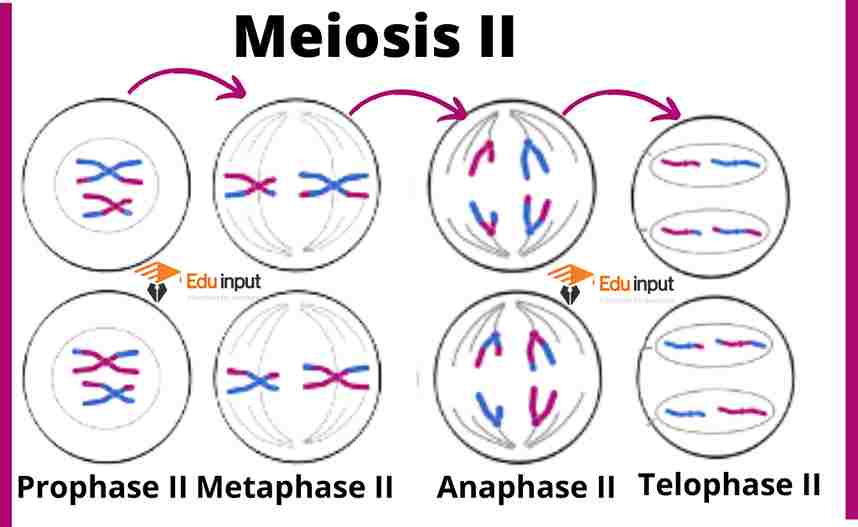What is Meiosis-I?-Definition and Stages
Gamete formation in sexual reproduction occurs through meiosis. Meiosis-I is the particular type of cell division in which the number of chromosomes in daughter cells is reduced to one-half, as compared to the parent cell. It is the first stage of meiosis.
Meiosis takes place only in diploid cell types. Meiosis occurs in animals at the time of gamete formation. But in plants, it happens during the formation of spores.
Two consecutive divisions occur after a single DNA replication during meiosis.
These two divisions are
- Meiosis I
- Meiosis II
Thus, each diploid cell produces four haploid cells as a result of meiosis.
Meiosis-I
The first meiotic division is the reduction division. Here are its phases:
Prophase I
This is a very long phase. The chromosomes behave as homologous pairs during meiosis. It, therefore, differs from the prophase of mitosis. Thus, each chromosome is not organized into homologous pairs.
In a diploid cell, there are two chromosomes of each type. Every chromosome has two chromatids. One member of this pair comes from each parent from the fusion of male and female gametes.
Chromosomes replicate during interphase. So each chromosome has two chromatids. The interphase of meiosis lack G₂ stage.
homologous chromosome
The similar but not necessarily identical chromosomes are called homologous chromosomes.
Prophase I further consists of the followings stages:
Leptotene (ribbon-like)
The chromosomes shorten and become thick. Thus, they become visible. The size of the nucleus increases and the homologous chromosomes begin to approach each other.
Zygotene
The homologous chromosomes start pairing during zygotene. It is called synapsis.
This is the first essential phenomenon of meiosis. This pair is very specific. An exact point-to-point match takes place.
But this pairing does not have a certain starting point. Any paired (but not fused) complex structure is called a bivalent or a tetrad.
Pachytene (conditioning)
The pairing of homologous chromosomes is complete. The chromosomes become denser. Each bivalent has four chromatids. These chromatids fold around each other. Crossing over occurs in this phase.
crossing over
The non-sister chromatids of homologous chromosomes exchange segments. This process is called crossing over. Thus reshuffling of genetic material takes place during crossing over. Crossing over produces new recombination of DNA.
Pachytene can last for days, weeks, or even years. But leptotene and zygotene last only for a few hours. Diplotene: the paired chromosomes repel each other in opposite directions. So they begin detachment from each other.
The homologous chromosomes remain connected by chiasmata. So separation is not complete. Each bivalent possesses at least one chiasmata. Otherwise, the chromatids can separate from each other.
Diplotene
The paired chromosomes repel each other. So they begin to separate from each other. The homologous chromosomes remain united by chiasmata. So separation is not complete. Each bivalent has at least one chiasmata. Otherwise, the chromatids can separate from each other.
Diakinesis
The condensation of chromosomes reaches its maximum point during this phase. At the same time separation of the homologous chromosomes is completed. But still, they are united at one point at its end. The nucleoli disappear.

Metaphase I
The nuclear membrane becomes disorganized (disappears) at the beginning of this phase. Spindle fibers originate from the kinetochore fibers. They attach to the kinetochore of the homologous chromosome at each pole. They arrange the bivalents at the equator. The sister chromatids of a chromosome in the bivalent act as a unit.
Anaphase I
Kinetochore fibers contract and the spindle or pole fibers extend. It drags the chromosome (each having two chromatids) towards its respective poles. The sister chromatids are not separated. But the sister chromatids are separated in the anaphase of mitosis. Each pole acquires half of the total chromosomes. So this is the real reduction phase.
Telophase I
The nuclear membrane reorganizes around each set at two poles. The nucleoli reappear. The two nuclei are constituted. Each nucleus carries half the number of chromosomes. The division of the cytoplasm (Cytokinesis) divides the cell into two. It terminates the first meiotic division. Chromosomes are decondensed during this stage.

Related FAQs
What happens in meiosis I?
In meiosis I, the resegregation of chromosomes occur to produce two haploid daughter cells. It is the reduction phase as compared to meiosis II.
What is meiosis I and meiosis II?
Meiosis I is the reduction phase in which homologous chromosomes are separated and four haploid daughter cells are produced. While Meiosis II is like mitosis, in which there are no changes in chromosome number.
What is another name for Meiosis I?
Meiosis I is also known as the Reduction Phase of the cell cycle.
What are the stages of Meiosis I?
Meiosis I consists of four stages:
Prophase I
Metaphase I
Anaphase I
Telophase I
What is the purpose of Meiosis I?
Meiosis primarily happens to separate homologous chromosomes.
Where does meiosis occur?
Meiosis occurs in germ cells, specifically in the reproductive organs. This includes the gonads in animals (e.g., testes in males and ovaries in females) and specialized structures in plants (e.g., ovules and pollen sacs).

 written by
written by 





Leave a Reply